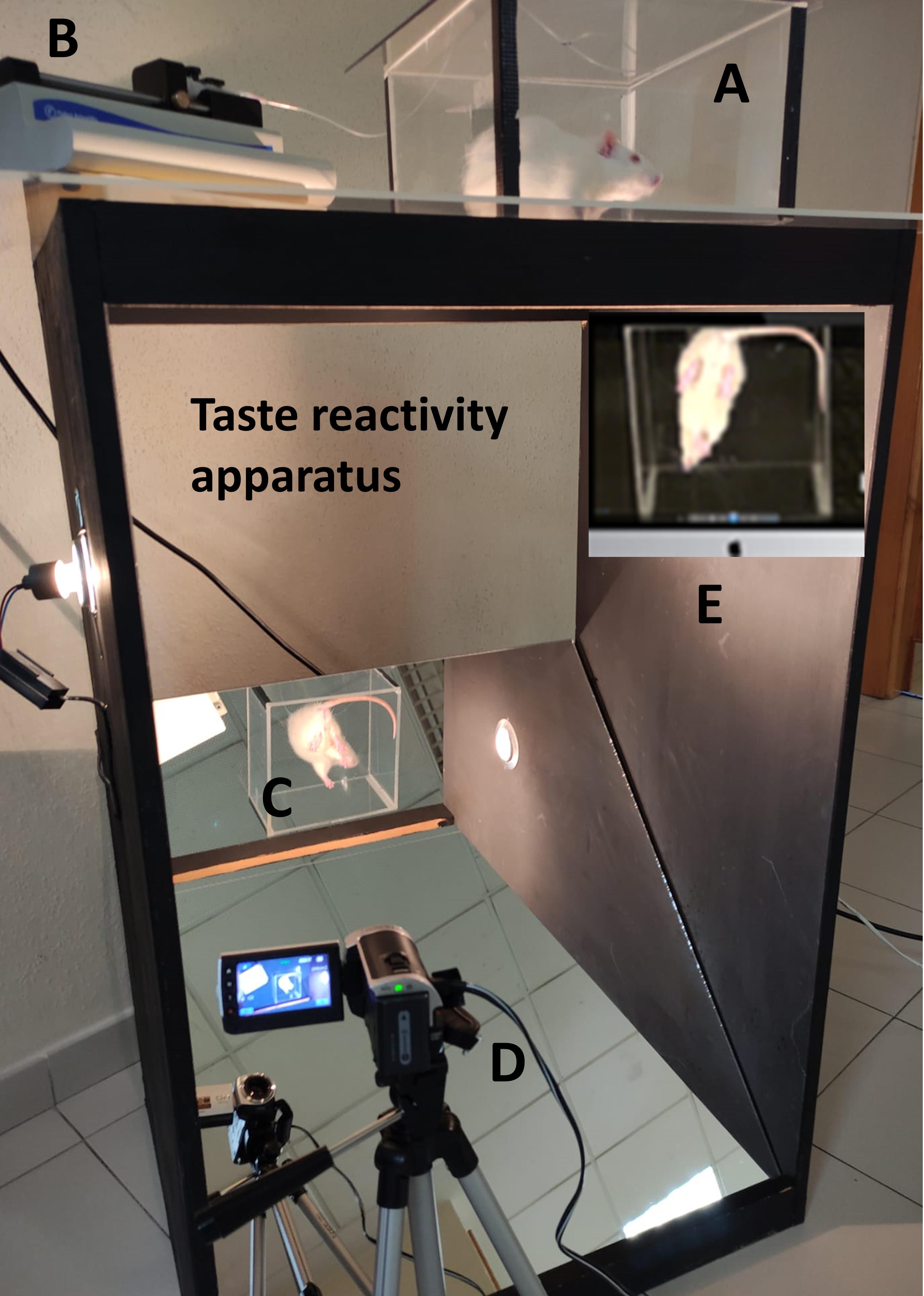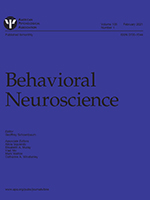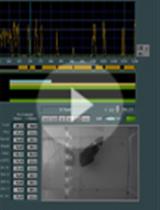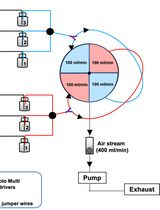- EN - English
- CN - 中文
Characterizing Hedonic Responses to Flavors Paired with Internal Pain and Nausea through the Taste Reactivity Test in Rats
通过大鼠的味觉反应性测试来描述与内痛和恶心配对的味道的快乐反应
(*contributed equally to this work) 发布: 2022年09月20日第12卷第18期 DOI: 10.21769/BioProtoc.4515 浏览次数: 2106
评审: Edgar Soria-GomezWeiyan JiaAnonymous reviewer(s)
Abstract
Feeding behavior is a complex experience that involves not only sensory (i.e., visual, odor, taste, or texture) but also affective or emotional aspects (i.e., pleasure, palatability, or hedonic value) of foods. As such, behavioral tests that assess the hedonic impact of foods are necessary to fully understand the factors involved in ingestive behavior. In this protocol, we use the taste reactivity (TR) test to characterize the hedonic responses of rats to flavors paired with either lithium chloride–induced nausea or internal pain produced by hypertonic NaCl, two treatments that reduce voluntary consumption. This application of the TR test demonstrates how emetic and non-emetic (somatic pain in particular) treatments produce dissociable patterns of hedonic reactions to fluids: only emetic treatments result in the production of aversive orofacial responses, reflecting conditioned nausea, whereas somatic pain produces immobility, reflecting conditioned fear. Other methods, such as the microstructural analysis of licking behavior, do not reliably distinguish conditioned nausea and fear, a key advantage of the more selective TR procedure. This protocol also contains guidance for adaptation to other species and designs.
Keywords: Taste aversion (口味厌恶)Background
In rats, pairing a novel flavored solution with nausea produced by the administration of emetic drugs such as lithium chloride (LiCl) results in the subsequent reduction in consumption of that flavor, a learning phenomenon termed conditioned taste aversion (CTA) (see Reilly and Schachtman, 2009 for a review). Critically, not only does CTA result in decreased consumption of that flavor, but there is also evidence of a change in its palatability or hedonic qualities, as suggested by John Garcia, the pioneer in studying this learning phenomenon (Garcia et al., 1955). However, CTA is not exclusively produced by emetic treatments. Pairing flavors with a wide variety of other aversive events, including pain produced by footshock or injection of hypertonic saline, as well as the administration of many drugs of abuse, reliably produces reductions in voluntary consumption (e.g., Pelchat et al., 1983; Parker, 1995; Arthurs et al., 2012). Thus, one central issue in this protocol is whether emetic and non-emetic treatments produce the same sorts of behavioral affective reactions to fluids. The taste reactivity (TR) protocol we describe here can be generalized for many uses, including determining whether a novel substance or intervention is aversive because it produces pain or nausea (and similarly whether a treatment ameliorates pain/nausea). Additionally, this procedure is amenable to be adapted for studying the neural mechanisms of hedonic evaluation (Inui and Simura, 2017), or for examining the role of anhedonia in psychiatric and neurological disorders such as depression and schizophrenia (Ward et al., 2012).
The optimal method affording a direct assessment of the hedonic impact of flavors is the TR test (Grill and Norgren, 1978). This involves examining orofacial reactions—stereotyped oromotor and somatic consummatory responses—elicited during the intraoral infusion of the fluid in the rat’s oral cavity. These orofacial responses can be classified as aversive (e.g., gaping, chin rubbing, and paw treading), elicited when infused with unpleasant sour or bitter tastes, or appetitive (e.g., tongue protrusions, mouth movements, and paw licks), elicited by pleasant, sweet tastes. When infused with a palatable taste (e.g., saccharin) previously paired with LiCl-induced nausea, rats display aversive responses, reflecting a shift in the hedonic value of the flavor from positive to negative. Importantly, this technique is selective to disgust, in contrast to the reduction in consumption that may simply reflect taste avoidance without a change in affective responses. As mentioned above, pairing a flavor with peripheral pain or with rewarding drugs, such as cocaine or amphetamine, results in a reduction in subsequent voluntary consumption of that flavor, but not in the production of orofacial aversive responses (Parker, 1995). This dissociation in the impact of emetic drugs and other aversive events supports the suggestion that a reduction in fluid intake may be motivated by two different processes: a taste associated with nausea causes a reduction in its palatability (CTA), whereas a taste associated with a drug of abuse or peripheral pain is avoided because it signals a potential danger or a disturbance in homeostasis regulation [taste avoidance learning (TAL)] (see Parker 2003, 2014).
The hedonic value of flavors can also be examined by analyzing the microstructure of licking behavior during voluntary consumption (Davis, 1989; Dwyer, 2012). The ingestive behavior of rodents consuming fluids consists of sustained runs of licks separated by pauses of varying length (clusters); the mean number of licks in a cluster (lick cluster size) is directly related to the nature and concentration of the solution ingested. Lick cluster size shows a positive monotonic relationship to the concentration of palatable sweet solutions, decreasing monotonically with an increased concentration of unpalatable quinine solutions. In the context of taste aversion learning, pairing an otherwise palatable taste with nausea results in a reduction of lick cluster size, similar to that produced by exposure to quinine. However, reductions in cluster size cannot be unambiguously attributed to conditioned disgust (for example, these do not distinguish between the effects of hypertonic saline and isotonic lithium chloride as described here) in the absence of careful observation of orofacial behavioral reactions directly indicative of a particular emotional response. With this issue in mind, here we use the orofacial reactivity protocol to selectively characterize hedonic responses to flavors paired with either nausea or internal pain caused by injection of hypertonic saline.
Materials and Reagents
PE-160 intramedic polyethylene tubes (Becton Dickinson, MD, USA, catalog number: 427431) attached to an infusion pump, for intraoral infusion
15-gauge stainless steel needles (Kruuse, Denmark, catalog number: 120753), to implant intraoral cannula
Microlance 3 25 g × 5/8" hypodermic needles (Becton Dickinson, MD, USA, catalog number: 300600), for injection procedures
Animals: Wistar rats (280–393 g, male, 9 weeks old; University of Oviedo vivarium, Spain)
Fluids used for intraperitoneal injections: LiCl (0.15 M,10 mL/kg) (VWR Chemicals, catalog number: 25007-230), NaCl (1.5 M, 10 mL/kg), and isotonic saline (0.9%,10 mL/kg) (VWR Chemicals, catalog number 27810-262)
Flavor used for intraoral infusion: 0.1% (w/w) saccharin sodium (Sigma-Aldrich, Merck, catalog number: 47839)
Ketamine hydrochloride (50 mg/kg) (Sigma-Aldrich, Merck, catalog number: 1356009)
Medetomidine hydrochloride (0.15 mg/kg) (Sigma-Aldrich, Merck, catalog number: 1179333)
Ketoprofen (1.5 mg/kg) (Sigma-Aldrich, Merck, catalog number: 1356632)
Enrofloxacin (0.3 mg/kg) (Sigma-Aldrich, Merck, catalog number: 17849)
Chlorhexidine (0.3 mg/kg) (Sigma-Aldrich, Merck, catalog number: 282227)
PE-90 intramedic polyethylene tubes (Becton Dickinson, MD, USA, catalog number: 427519) for intraoral cannula
O-ring Mini Stix ligature ties (TP Orthodontics Inc., IN, USA, catalog number: 383-927), to hold securely the PE-90 tubes in the oral cavity
Injection syringes 1 mL (Becton Dickinson, catalog number: 309628) and 5 mL (BD, catalog number: 309646)
Equipment
Custom-made TR apparatus (see Figure 1)
Infusion pump (KD Scientific Inc, MA)
Video camera (Sony Optical 20×) connected to a desktop computer

Figure 1. Taste reactivity apparatus. Front view of the TR apparatus with the different components. (A) Infusion chamber. (B) Infusion pump. (C) Mirror at a 45° angle. (D) Video camera. (E) Computer. See Note 2 for a more detailed description of the apparatus.
Software
The Observer XT 9.0 (Noldus Information Technology, Sterling, VA) event-recording program, to score videos. This computer software is an automated system that makes it possible to record the behavior of animals directly in the TR chamber and code the sequence and duration of the behaviors exhibited in a quantitative way.
Procedure
文章信息
版权信息
© 2022 The Authors; exclusive licensee Bio-protocol LLC.
如何引用
López, M., Dwyer, D. M., Gasalla, P., Jove, C. and Begega, A. (2022). Characterizing Hedonic Responses to Flavors Paired with Internal Pain and Nausea through the Taste Reactivity Test in Rats. Bio-protocol 12(18): e4515. DOI: 10.21769/BioProtoc.4515.
分类
神经科学 > 行为神经科学 > 嗅觉
您对这篇实验方法有问题吗?
在此处发布您的问题,我们将邀请本文作者来回答。同时,我们会将您的问题发布到Bio-protocol Exchange,以便寻求社区成员的帮助。
Share
Bluesky
X
Copy link












